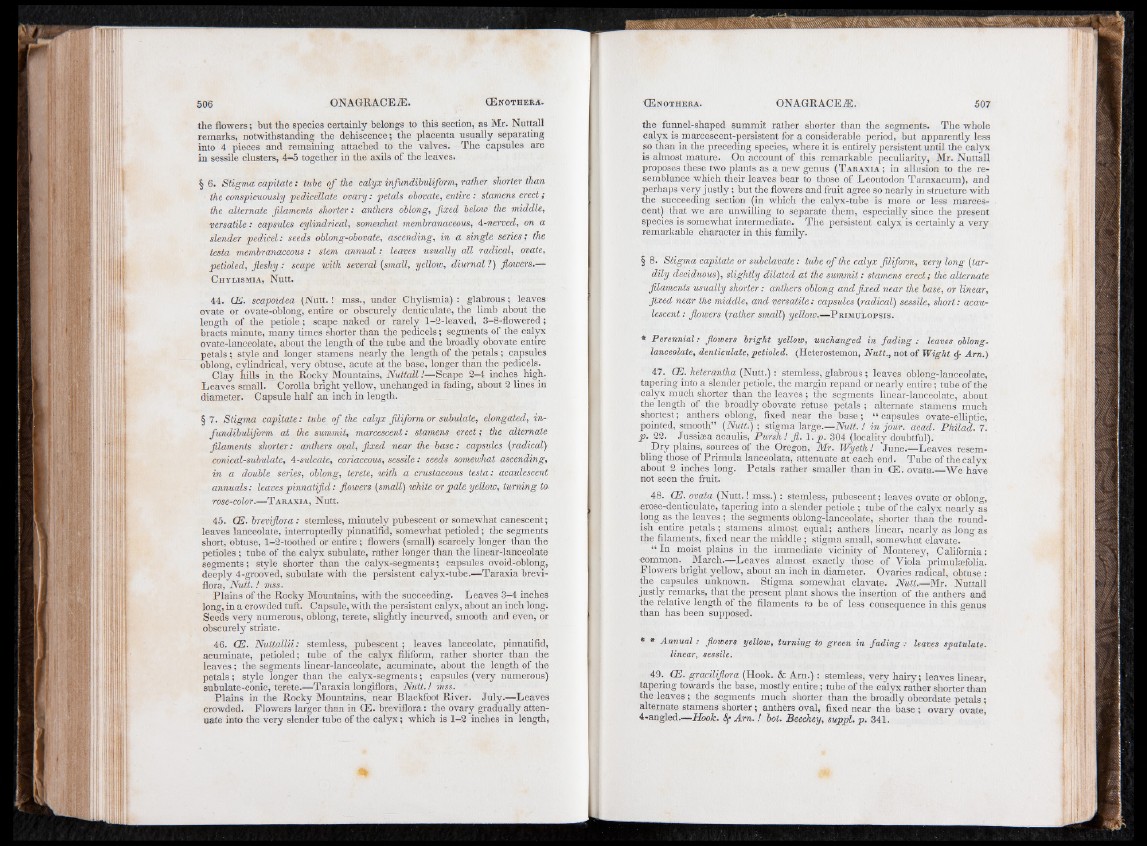
the flowers; but the species certainly belongs to this section, as Mr. Nuttall
remarks, notwithstanding the dehiscence; the placenta usually separating
into 4 pieces and remaining attached to the valves. The capsules are
in sessile clusters, 4-5 together in the axils of the leaves.
§ 6. Stigma capitate: tube of the calyx infundibuliform, rather shorter than
the conspicuously pedicellate ovary: petals obovate, entire: stamens erect;
the alternate filaments shorter: anthers oblong, fixed below the middle,
versatile: capsules cylindrical, somewhat membranaceous, i-nerved, on a
slender pedicel: seeds oblong-obovate, ascending, in a single series; the
testa membranaceous : stem annual: leaves usually all radical, ovate,
petroled, fleshy: scape with several (small, yellow, diurnal ?) flowers.—
Chylismia, Nutt.
44. CE. scapoidea (Nutt.! mss., under Chylismia) : glabrous; leaves
ovate or ovate-ohlong, entire or obscurely denticulate, the limb about the
length of the petiole; scape naked or rarely 1-2-leaved, 3-8-flowered;
bracts minute, many times shorter than the pedicels; segments of the calyx
ovate-lanceolate, about the length of the tube and the broadly obovate entire
petals; style and longer stamens nearly the length of the petals ; capsules
oblong, cylindrical, very obtuse, acute at the base, longer than the pedicels.
Clay hills in the Rocky Mountains, Nuttall!—Scape 2-4 inches high.
Leaves small. Corolla bright yellow, unchanged in fading, about 2 lines in
diameter. Capsule half an inch in length.
§ 7. Stigma capitate: tube of the calyx filiform or subulate, elongated, infundibuliform
at the summit, marcescent: stamens erect; the alternate
filaments shorter: anthers oval, fixed near the base: capsules (radical}
conical-subulate, 4-sulcate, coriaceous, sessile: seeds somewhat ascending,
in a double series, oblong, terete, with a crustaceous testa: acaulescent
annuals: leaves pinnatifid: flowers (small) white or pale yellow, turning to
rose-color.—T araxia, Nutt.
45. CE. breviflora: stemless, minutely pubescent or somewhat canescent;
leaves lanceolate, interruptedly pinnatifid, somewhat petioled; the segments
short, obtuse, 1-2-toothed or entire ; flowers (small) scarcely longer than the
petioles ; tube of the calyx subulate, rather longer than the linear-lanceolate
segments; style shorter than the calyx-segments; capsules ovoid-oblong,
deeply 4-grooved, subulate with the persistent calyx-tube.—Taraxia breviflora,
Nutt.! mss.
Plains of the Rocky Mountains, with the succeeding. Leaves 3-4 inches
long, in a crowded tuft. Capsule, with the persistent calyx, about an inch long.
Seeds very numerous, oblong, terete, slightly incurved, smooth and even, or
obscurely striate.
46. CE. Nuttallii: stemless, pubescent; leaves lanceolate, pinnatifid,
acuminate, petioled; tube of the calyx filiform, rather shorter than the
leaves; the segments linear-lanceolate, acuminate, about the length of the
petals; style longer than the calyx-segments; capsules (very numerous)
subulate-conic, terete.—Taraxia longiflora, Nutt.! mss.
Plains in the Rocky Mountains, near Blackfoot River. July.—Leaves
crowded. Flowers larger than in CE. breviflora: the ovary gradually attenuate
into the very slender tube of the calyx; which is 1-2 inches in length,
the funnel-shaped summit rather shorter than the segments. The whole
calyx is marcescent-persistent for a considerable period, but apparently less
so than in the preceding species, where it is entirely persistent until the calyx
is almost mature. On account of this remarkable peculiarity, Mr. Nuttall
proposes these two plants as a new genus (T araxia ; in allusion to the resemblance
which their leaves bear to those of Leontodon Taraxacum), and
perhaps very justly; but the flowers and fruit agree so nearly in structure with
the succeeding section (in which the calyx-tube is more or less marcescent)
that we are unwilling to separate them, especially since the present
species is somewhat intermediate. The persistent calyx is certainly a very
remarkable character in this family.
§ 8. Stigma capitate or subclavate: tube of the calyx filiform, very long (tardily
deciduous), slightly dilated at the summit: stamens erect; the alternate
filaments usually shorter: anthers oblong and fixed near the base, or linear,
fixed near the middle, and versatile: capsules (radical) sessile, short: acaulescent
: flowers (rather small) yellow.—P rimulopsis.
* Perennial: flowers bright yellow, unchanged in fading : leaves oblong,
lanceolate, denticulate, petioled. (Heterostemon, Nutt., not of Wight & Am.)
47. CE. heterantha (Nutt.): stemless, glabrous ; leaves oblong-lanceolate,
tapering into a slender petiole, the margin repand or nearly entire; tube of the
calyx much shorter than the leaves; the segments linear-lanceolate, about
the length of the broadly obovate retuse petals ; alternate stamens much
shortest; anthers oblong, fixed near the base; “ capsules ovate-elliptic,
pointed, smooth” (Nutt.); stigma large.—Nutt. ! in jour. acad. Philad. 7.
p. 22. Jussiaea acaulis, Pursh! fl. 1. p. 304 (locality doubtful).
Dry plains, sources of the Oregon, Mr. Wyeth ! June.—Leaves resembling
those of Primula lanceolata, attenuate at each end. Tube of the calyx
about 2 inches long. Petals rather smaller than in CE. ovata.—We have
not seen the fruit.
48. CE. ovata (Nutt.! mss.): stemless, pubescent; leaves ovate'or oblong,
erose-dentieulate, tapering into a slender petiole ; tube of the calyx nearly as
long as the leaves ; the segments oblong-lanceolate, shorter than the roundish
entire petals; stamens almost equal; anthers linear, nearly as long as
the filaments, fixed near the middle ; stigma small, somewhat clavate.
“ In moist plains in the immediate vicinity of Monterey, California:
common. March.—Leaves almost exactly those of Viola primulcefolia.
Flowers bright yellow, about an inch in diameter. Ovaries radical, obtuse :
the capsules unknown. Stigma somewhat clavate. Nutt.—Mr. Nuttall
justly remarks, that the present plant shows the insertion of the anthers and
the relative length of the filaments to be of less consequence in this genus
than has been supposed.
* * Annual : flowers yellow, turning to green in fading : leaves spatulate.
linear, sessile.
49. CE. graciliflora (Hook. & Arn.): stemless, very hairy; leaves linear,
tapering towards the base, mostly entire; tube of the calyx rather shorter than
the leaves ; the segments much shorter than the broadly obcordate petals ;
alternate stamens shorter; anthers oval, fixed near the base ; ovary ovate^
4-angled.—Hook. 8f Arn. ! hot. Beechey, suppl.p. 341.